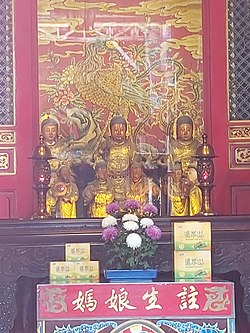Religion:Bixiao Niangniang

Bixiao Xianzi (Chinese: 碧霄仙子; literally: 'the Green Firmament Celestial Maiden'), also known as Zhao Bixiao, is a character in the classic 16th-century Chinese novel Fengshen Yanyi. She is worshipped as a goddess of childbirth in Chinese folk religion.[1] She is one of the Sanxiao Shengmu (Holy mothers of three skies, 三霄聖母) or Sanxiao Niangniang (Ladies of three stars, 三霄娘娘).[2][3][4][5]
Legend
According to Fengshen Yanyi, she is one of the first-generation disciples of the Jie Sect, apprenticed to Tongtian Jiaozhu. Among the Three Celestial Maidens, she is said to be the youngest. Assuming human form on Sanxian Island, she resided there with her two sisters, Yunxiao and Qiongxiao, for spiritual cultivation. Bixiao has a more impulsive personality, unlike her older sister Yunxiao, who is calm and steady. Her mount was a flower-feathered bird, and she, along with her two sisters, possessed two powerful immortal treasures: the Golden Dragon Shears and the Chaos-Origin Gold Gourd. Their senior brother was Zhao Gongming of Mount Emei. After her elder brother's tragic demise at the hands of Luya Daoren, she, along with her sisters, vowed to seek revenge. She actively participated in the conflict, offering support to the Grand Preceptor Wen Zhong.[6]
The three sisters, accompanied by their fellow disciples Caiyun Fairy and Hanzhi Fairy, engaged in an intense battle against the disciples of the Chan Sect. They deployed the Grand Nine-Curves Yellow River Formation (九曲黄河阵), capturing Yang Jian, Jinzha, and Muzha with the Chaos-Origin Gold Gourd. They also subdued the Twelve Golden Immortals and Luya Daoren, using the Grand Nine-Curves Yellow River Formation to weaken their cultivation, which had been accumulated over a thousand years.[6]
Observing that no one within the Chan Sect could vanquish Sanxiao, both Yuanshi Tianzun and Laozi came down to help their disciples and successfully dismantled the Grand Nine-Curves Yellow River Formation. A verbal conflict ensued between Sanxiao and the two great sages. In a daring move, Bixiao wielded her sword against Yuanshi Tianzun, only to be disarmed by Xianhe Tongzi (the White Crane Boy) . Yuanshi Tianzun then trapped her in a treasure chest, leading to her transformation into blood. Yunxiao was pressed to death beneath the Qiankun Diagram (乾坤图), which was activated by Laozi's Yellow Turban Warriors (黄巾力士), while Qiongxiao met her end at the hands of the White Crane Boy's Three Treasures Wish-Granting Scepter (三宝玉如意). In the end, the sisters were collectively honored with the divine title of "Ganying Sui Shi Xiangu" (感应随世仙姑, lit. 'Sensitivity and Harmony Celestial Ladies') by Jiang Ziya. Together, the three sisters are known to the world as the "Three Celestial Maidens" or "Sanxiao Niangniang". They are revered both as goddesses of fertility and for their role in overseeing ailments such as smallpox and childhood diseases.[7][6]
Worship

In Taiwan's folk religion, the three sisters are often merged into a singular deity known as Zhusheng Niangniang.[2]
Inside the Sanxiao Hall at Changchun Temple in Anyang, the Three Celestial Maidens are enshrined. They are believed to wield control over the Hunyuan Gold Gourd, which, as it rotates, is thought to shape the destinies of all beings, regardless of their social standing or wealth. In bygone eras, individuals would beseech the Three Celestial Maidens for assistance with matters related to childbirth and fertility, bestowing upon them the widely recognized titles of "Goddesses of Fertility" or "Maternal Deities". The Three Celestial Maidens occupy a significant and revered position in Chinese folk belief, resulting in the creation of numerous legends and tales about them.[8]
In Qinhuangdao, Hebei Province, there exists a street known as Cai Shen Temple Street. Following the passing of Zhao Gongming, his spirit ascended to the Investiture of the Gods platform. Subsequently, Jiang Ziya conferred upon him the title of 'God of Wealth,' entrusting him with the responsibility of overseeing matters related to wealth and prosperity throughout the land. The three sisters could never forget their affection for their senior brother. Consequently, they constructed a temple dedicated to the God of Wealth in a sunlit location at the base of Jieshi Mountain. This temple served to honor Zhao Gongming and express their profound love for him. Over time, people from various regions seeking good fortune and prosperity congregated in the vicinity of the God of Wealth temple. Gradually, this area evolved into a bustling street, now recognized as Cai Shen Temple Street in Changli City.
References
- ↑ Harris, Rachel A.; Pease, Rowan; Tan, Shzr Ee (2013) (in en). Gender in Chinese Music. University Rochester Press. ISBN 978-1-58046-443-7. https://books.google.com/books?id=5MlVUda3aGkC&dq=Sanxiao+childbirth&pg=PA165.
- ↑ 2.0 2.1 Chen, Fan-Pen Li (2007) (in en). Chinese Shadow Theatre: History, Popular Religion, and Women Warriors. McGill-Queen's Press - MQUP. ISBN 978-0-7735-3197-0. https://books.google.com/books?id=aZu9Cje8TfkC&dq=Zhao+Yunxiao&pg=PA175.
- ↑ Overmyer, Daniel (30 September 2009) (in en). Local Religion in North China in the Twentieth Century: The Structure and Organization of Community Rituals and Beliefs. BRILL. ISBN 978-90-474-2936-4. https://books.google.com/books?id=SCewCQAAQBAJ&dq=Yunxiao+Guniang&pg=PA135.
- ↑ "The Dark History of Conferred Gods: Yunxiao was killed innocently by unspoken rules Jiang Taigong leaked the Yellow River and changed Shanxi folklore". INF News. 18 March 2021. https://inf.news/en/culture/aafcced061c69ebe6e669bf915c0dc4f.html.
- ↑ Chen, Fan-Pen Li (2007) (in en). Chinese Shadow Theatre: History, Popular Religion, and Women Warriors. McGill-Queen's Press - MQUP. ISBN 978-0-7735-3197-0. https://books.google.com/books?id=aZu9Cje8TfkC&dq=Sanxiao+Shengmu&pg=PA109.
- ↑ 6.0 6.1 6.2 (in zh-TW) 跟著廟口說書人看廟趣: 聽!郭喜斌戲說彩繪╳剪黏╳交趾╳木雕╳石雕經典裝飾故事. Morning Star Publishing Inc (晨星出版有限公司). 5 December 2021. ISBN 978-626-320-040-1. https://books.google.com/books?id=8O5ZEAAAQBAJ&dq=%E7%A2%A7%E9%9C%84%E4%BB%99%E5%AD%90&pg=PA40.
- ↑ Stuart, Kevin; Li, Xuewei (1994) (in en). China's Dagur Minority: Society, Shamanism, & Folklore. University of Pennsylvania, Department of Asian and Middle Eastern Studies. https://books.google.com/books?id=5zZwAAAAMAAJ&q=Bixiao+Niangniang.
- ↑ (in zh) 中國考古集成: Zong shu. 中州古籍出版社. 2003. https://books.google.com/books?id=zdMQAQAAMAAJ&q=%E9%95%BF%E6%98%A5%E8%A7%82%E4%B8%89%E9%9C%84%E6%AE%BF.
 |
